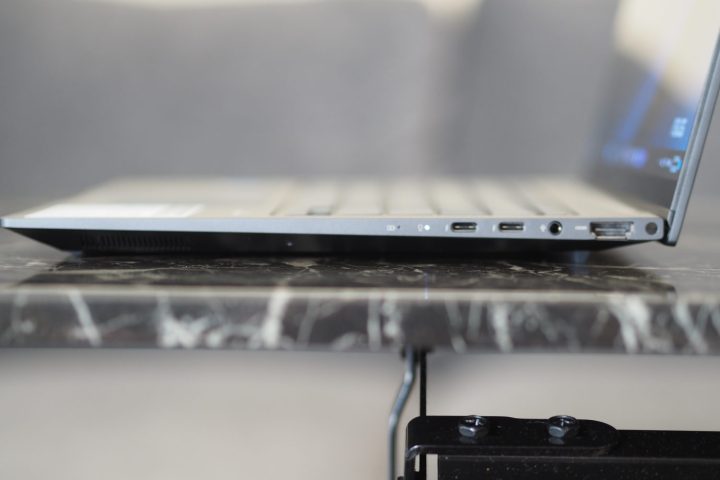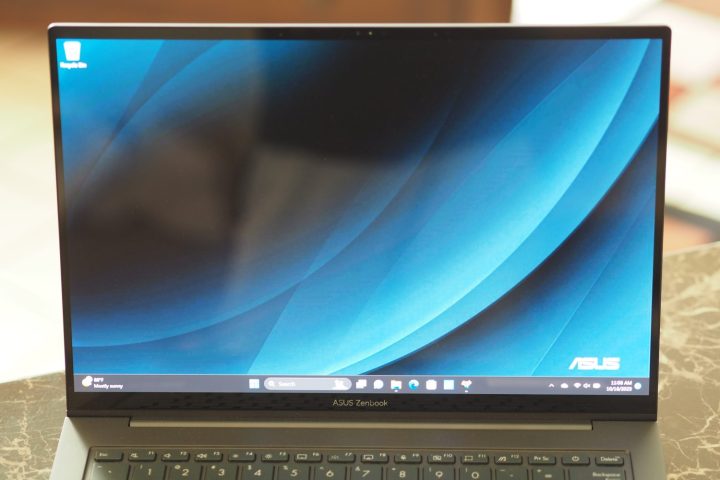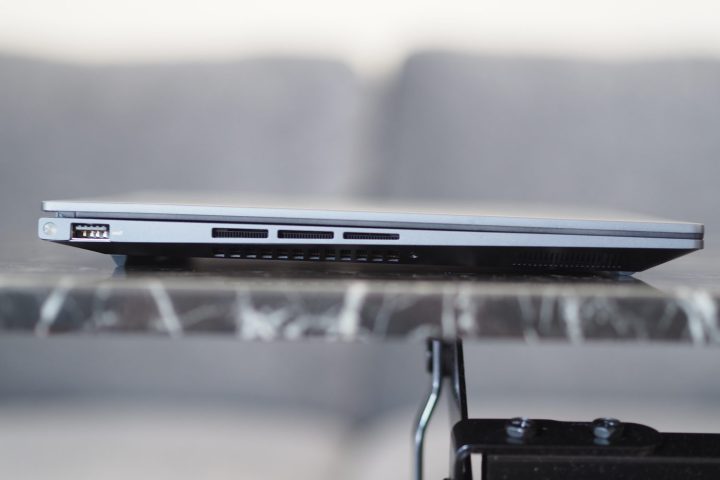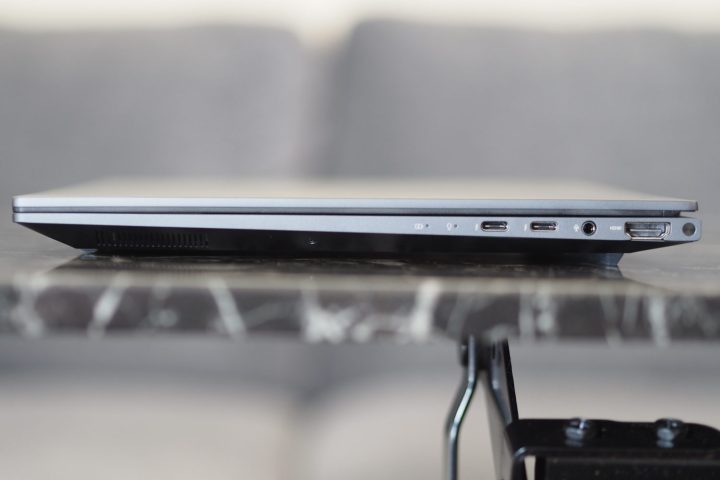Asus Zenbook 14X OLED
MSRP $1,000.00
“The Asus Zenbook 14X OLED is best judged by its spectacular OLED display and attractive pricing.”
Pros
- Attractive price
- Solid build quality
- Very good productivity performance
- Spectacular OLED display
- Excellent keyboard and touchpad
Cons
- Not as strong a value with a discrete GPU
- Creative performance isn’t great
- Battery life is just average
The Asus Zenbook 14 OLED is easily the best value laptop you can buy. For $700, it’s the complete package.
The Zenbook 14X OLED, though, takes it one step further. It swaps out AMD for Intel, adds a faster refresh rate display, and pumps up the performance. And while it’s not quite as much of a deal, the Zenbook 14X remains one of the best laptops you can buy, especially if you’re looking for a slightly more premium option.
Specs and configurations
| Asus Zenbook 14X OLED | |
| Dimensions | 12.67 inches x 8.88 inches x 0.67 inches |
| Weight | 3.44 pounds |
| Processor | Intel Core i5-13500H
Intel Core i7-13700H Intel Core i9-13900H |
| Graphics | Intel Iris Xe Nvidia GeForce RTX 3050 |
| RAM | 8GB 16GB 32GB |
| Display | 14.5-inch 16:10 2.8K (2,880 x 1,800) OLED, 120Hz |
| Storage | 512GB SSD 1TB SSD |
| Touch | Yes |
| Ports | 2 x USB-C with Thunderbolt 4 1 x USB-A 3.2 Gen 2 1 x HDMI 2.1 1 x 3.5mm audio jack |
| Wireless | Wi-Fi 6E and Bluetooth 5.2 |
| Webcam | 1080p with infrared camera for Windows 11 Hello facial recognition |
| Operating system | Windows 11 |
| Battery | 70 watt-hours |
| Price | $800+ |
Asus has three configurations available for the Zenbook 14X OLED. The entry-level model is $800 for a Core i5-13500H CPU, 8GB of RAM, a 512GB SSD, Intel Iris Xe graphics, and a 14.5-inch 2.8K OLED display. My review unit costs $1,000 and comes with a Core i7-13700H and 16GB of RAM. The high-end model is $1,500 for a Core i9-13900H, 32GB of RAM, 1TB SSD, and an Nvidia GeForce RTX 3050. The Zenbook 14X OLED is most attractively priced at its two lower-end configurations.
It’s well-equipped at $1,500 and still competitive, but it doesn’t stand out quite as strongly. Compared to the Zenbook 14 OLED, the base model is $100 more, but it has twice the storage space and it’s around $130 more expensive with an upgraded CPU. That makes it roughly as great a value. Another solid competitor is the Acer Swift Go 14 at around the same $1,000 price point and configuration, but its OLED display had inaccurate colors that held back its review rating.
Another excellent design for the money

I feel like I’m repeating myself review after review, but so many Windows laptops have adopted similar minimalist designs. They’re attractive, for the most part, but few stand out. The Zenbook 14X OLED fits that trend, with simple taper lines along the side and a solid Inkwell Grey color that looks a lot like black. Asus did add some flair with geometric lines in the lid, but once again, this is a laptop that blends in with the crowd. There’s a Sandstone Beige model that has a ceramic matte finish with a plasma “ceramization” (yes, that’s not misspelled) coating that’s more protective and resists fingerprints. I haven’t seen that model in person, though, so I can’t speak to differences in appearance.
The all-aluminum build is high quality, with no bending, flexing, or twisting in the keyboard deck or bottom chassis, and just the slightest bit in the lid. It’s not quite as solid as much more expensive laptops like the Lenovo Yoga 9i Gen 8, but the build quality is very good for the money.
Thanks to small display bezels on top and around the sides, the Zenbook 14X OLED is reasonably sized. It’s just 0.67 inches thick and weighs 3.44 pounds, which is getting a tad heavy for a 14-inch laptop. The Zenbook 14 OLED is roughly the same width and depth, and is equally thin, but it’s lighter at 3.06 pounds.

You’ll also like the Zenbook’s keyboard, which has snappy switches with plenty of travel and a light bottoming action. The keycaps are nicely sized, and there’s plenty of key spacing. It’s not the best keyboard I’ve used — HP’s Spectre keyboards and Apple’s Magic Keyboard earn that title — but it’s more than good enough for typing long sessions without experiencing fatigue. The touchpad is large and comfortable, and my only complaint is that the buttons give off a slightly sharp and loud sound.
Asus has included its NumberPad 2.0 embedded LED numeric keypad in the touchpad, which is great for anyone who enters a lot of numbers. The touchpad also has a hydrophobic and fingerprint-resistant coating to make the surface easier to clean and to increase resistance to wear.
Finally, the webcam runs at 1080p, which is becoming the new standard. There’s technology built in to further improve the image, and the Zenbook 14X OLED promises a great videoconferencing experience. There’s an infrared camera for Windows 11 Hello facial recognition, making logins a breeze.
Better performance, but battery life suffers

The Zenbook 14X OLED joins a number of 14-inch laptops that use 45-watt 13th-gen Intel CPUs matched with integrated Intel Iris Xe graphics. It’s a combination that offers fast productivity performance and decent speeds in creative tasks that are CPU-dependent. But many creative apps use the GPU to speed up performance, and these laptops aren’t good matches.
You can buy the Zenbook 14X OLED with an Nvidia GeForce RTX 3050, but even that won’t make much of a dent in applications like Adobe’s Premiere Pro.

However, if you’re primarily concerned about demanding productivity workflows, then the Zenbook 14X OLED is a strong performer. Its performance in our CPU-intensive benchmarks, as well as the PCMark 10 Complete suite, is roughly the same as other laptops with the Core i7-13700H in our review unit, and it’s a lot faster than the Zenbook 14 OLED with its 15-watt AMD processor.
Given the slim price difference between the two, you’ll be much happier with the Zenbook 14X OLED when it comes to sheer performance.
| Geekbench 5 (single / multi) | Handbrake (seconds) | Cinebench R23 (single / multi) | PCMark 10 Complete | |
| Asus Zenbook 14X OLED (Core i7-13700H) | Bal: 1,848 / 11,157 Perf: 1,852 / 11,160 | Bal: 84 Perf: 82 | Bal: 1,819 / 11,066 Perf: 1,826 / 12,795 | 6,020 |
| Asus Zenbook 14 OLED (Ryzen 5 7530U) | Bal: 1,457 / 7,527 Perf: 1,458 / 8,207 | Bal: 123 Perf: 121 | Bal: 1,457 / 7,527 Perf: 1,458 / 8,207 | 5,817 |
| Acer Swift Go 14 (Core i7-13700H) | Bal: 1,866 / 11,061 Perf: 1,854 / 11,824 | Bal: 82 Perf: 82 | Bal: 1,863 / 12,497 Perf: 1,915 / 13,554 | 5,996 |
| Samsung Galaxy Book3 Ultra (Core i7-13700H) | Bal: 1,647 / 12,206 Perf: 1,815 / 12,307 | Bal: 80 Perf: 74 | Bal: 1,712 / 13,278 Perf: 1,750 / 14,938 | 7,038 |
| Lenovo Slim 7 14 (AMD Ryzen 7 7735HS) | Bal: 1,493 / 9021 Perf: 1,498 / 9210 | Bal: 95 Perf: 84 | Bal: 1,551 / 12,536 Perf: 1,553 / 13,107 | 6,828 |
| Lenovo Yoga 9i Gen 8 (Core i7-1360P) | Bal: 1,843 / 8,814 Perf: 1,835 / 10,008 | Bal: 122 Perf: 101 | Bal: 1,846 / 8,779 Perf: 1,906 / 9,849 | 6,102 |
| Apple MacBook Air M2 (M2) | Bal: 1,925 / 8,973 Perf: N/A | Bal: 151 Perf: N/A | Bal: 1,600 / 7,938 Perf: N/A | N/A |
Battery life is where the Zenbook 14 OLED has the advantage, thanks both to the CPU’s lower power rating and AMD’s general efficiency. Compared to other similarly equipped laptops, though, the Zenbook 14X OLED was more competitive. Note that it wouldn’t complete our video-looping battery test, something I’ve been seeing with only a few other laptops.
But in our web-browsing test and the PCMark 10 Applications battery benchmark, the Zenbook X14 OLED performed around average, which typically translates into less than a full day of battery life. The Apple MacBook Air M2 is the standout laptop here, with significantly better battery life that can last into a second day’s work. The Zenbook 14 OLED was also significantly longer-lasting than our other comparison laptops.
| Web browsing | Video | PCMark 10 Applications | |
| Asus Zenbook 14X OLED (Core i7-13700H) | 8 hours, 2 minutes | N/A | 10 hours, 49 minutes |
| Asus Zenbook 14 OLED (Ryzen 5 7530U) | 12 hours, 13 minutes | 17 hours, 19 minutes | 14 hours, 23 minutes |
| Acer Swift Go 14 (Core i7-13700H) | 8 hours, 27 minutes | 11 hours, 51 minutes | 9 hours, 57 minutes |
| Dell XPS 15 9530 (Core i7-13700H) | 9 hours, 43 minutes | 11 hours, 46 minutes | 10 hours, 49 minutes |
| Lenovo Yoga 9i Gen 8 (Core i7-1360P) | 7 hours, 41 minutes | 13 hours, 25 minutes | 9 hours, 40 minutes |
| Apple MacBook Air M2 (Apple M2) | 17 hours, 59 minutes | 21 hours, 9 minutes | N/A |
An even better OLED display

Asus has led the pack by not only implementing OLED sooner than a lot of manufacturers, but also in placing OLED displays in very affordable laptops. You’ll find few in the same price range that can match the display quality, which is stunning out of the box with tons of color and inky blacks. Asus even incorporates various methods to help avoid OLED’s one potential pitfall, burn-in, including special screen savers and pixel shifting. The Zenbook 14X OLED’s display was a great example of the technology according to my colorimeter, with wide colors at 100% of sRGB, 98% of AdobeRGB, and 99% of DCI-P3. That’s average for OLED and much wider than the average IPS display’s 95% of sRGB and 75% of AdobeRGB. Color accuracy was also great at a DeltaE of 1.04 (less than 1.0 is considered excellent).
My colorimeter wouldn’t return results for the contrast ratio, which I’ve seen with several recent OLED displays. But with perfect black levels, you’re guaranteed to have extremely high contrast equal to other OLED displays and Mini-LED panels. The one advantage over the Zenbook 14 OLED, which performed similarly, is the ZenBook 14X OLED’s 120Hz refresh rate. The Zenbook 14 OLED tops out at 90Hz.
Overall, it’s an excellent display that will please productivity users, creators, and media consumers alike. Audio quality was just OK, with two downward-firing speakers providing adequate volume and quality for general computing needs. If you’re streaming an action movie or listening to music, you’ll want a good pair of headphones.
Another great laptop that’s also a great value
There’s a natural comparison between the Zenbook 14 OLED and the Zenbook 14X OLED, with both representing great values, particularly in their entry-level configurations. Which is a better value comes down to how much you value extra storage and a faster CPU. Then, you have to balance higher performance against longer battery life.
It’s a tough call. I went back and forth on how to rate the Zenbook 14X OLED. Yes, it’s more powerful than the Zenbook 14 OLED, but it also gets less battery life. And it’s slightly more expensive. In the end, I think it’s a slightly lesser value, so while I highly recommend it, I don’t think it deserves quite as high a ranking.
Editors’ Recommendations



